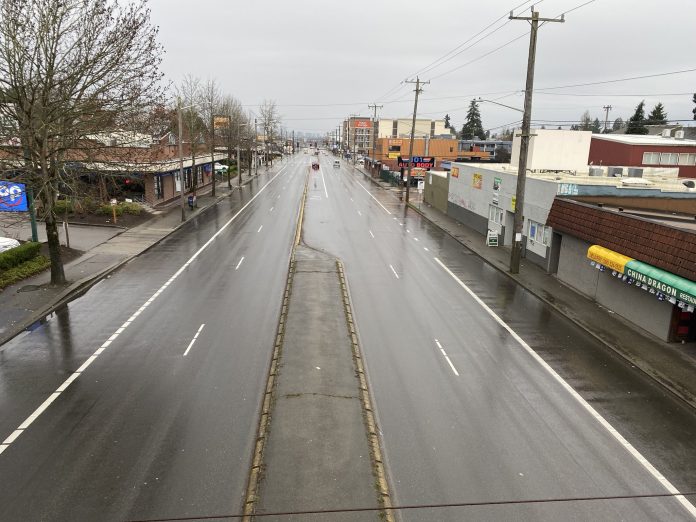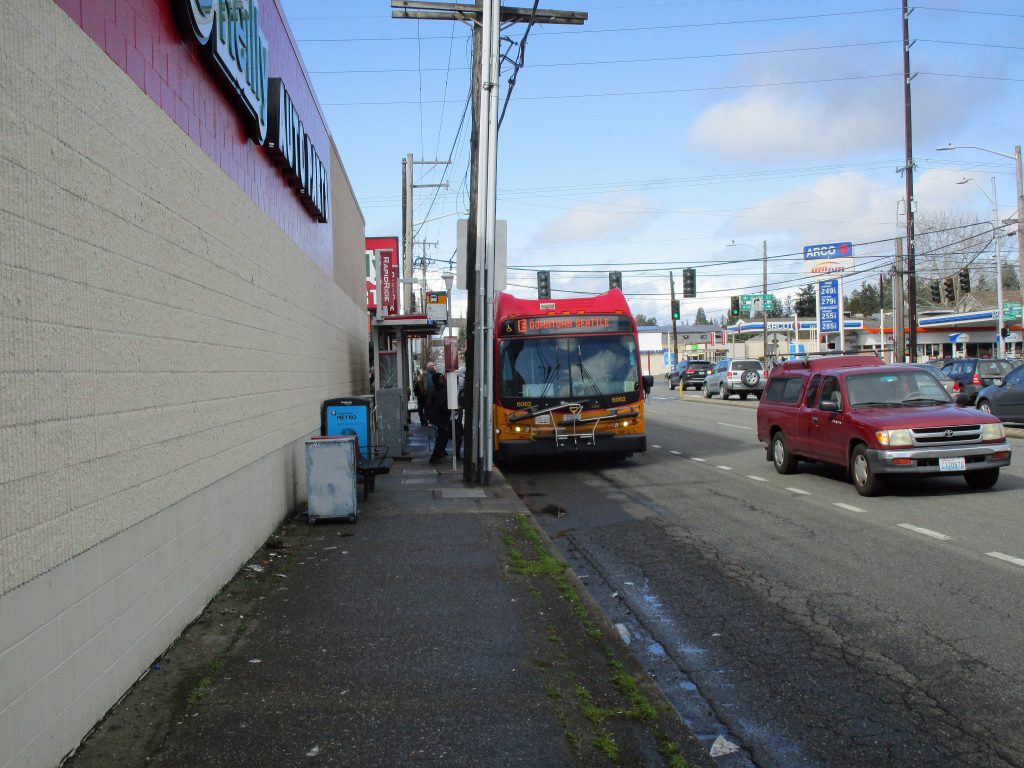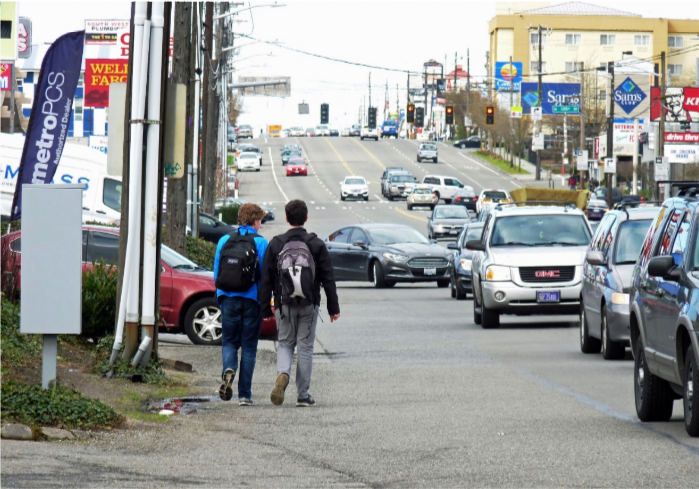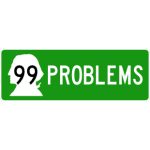Highway 99 has 99 problems. Aurora Avenue is an unsettled mix, part street where people interact with businesses and part highway shunting vehicles through at high speeds. It doesn’t work well for anybody; not for drivers, not for the 100,000 people living in its proximity, not for businesses, and not for safety.
In Queen Anne, it cuts off the neighborhood from Lake Union. In Fremont, there is a concrete barrier preventing cross-neighborhood access. At Woodland Park up through Green Lake, it’s a highway, increasing speeds with few stops as it plows through the Olmsted Parks that were planned 100 years ago. In Greenwood and Licton Springs, it divides an Urban Village and claims it’s a business street despite the noise and danger preventing any pedestrian from being comfortable. Even worse, in Bitter Lake, an entire mile of Aurora lacks sidewalks, leaving most people walking on the highway’s shoulder.
All of this leads to the worst problem of all. Aurora is deadly. This North Seattle road has the highest record of pedestrian deaths in the city. When the Aurora Reimagined Coalition was formed in 2021, the highway had taken 25 lives over the previous decade. We shared this statistic in our community meetings over the past year, but had to change that number to 26 and then to 27 in our slideshow presentations, as more lives were claimed by the street.
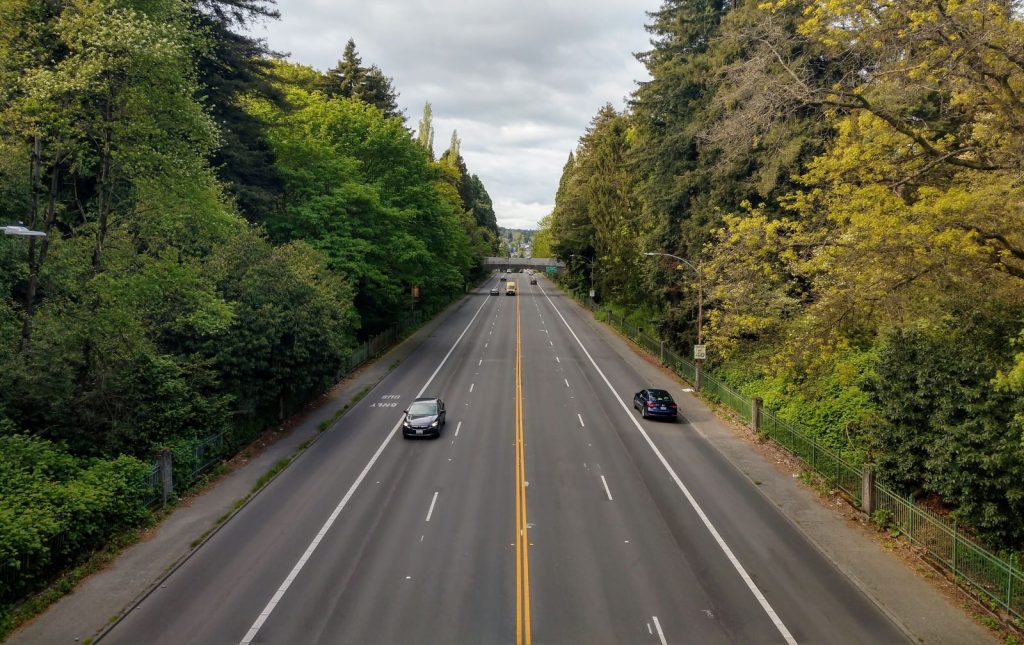
Why does the number of pedestrian deaths continue to rise? Because we prioritize cars over everything else. Sen. Reuven Carlyle (D-Seattle) wants to invest millions into the road to make it better. He is quoted as saying “Aurora could be the Champs-Élysées” and noted that the current design of Aurora is straight out of the 1950s. It’s worth noting that the vibrant, tree lined Parisian thoroughfare is also getting a refresh to reduce vehicle dependency to make the street more pleasant and sustainable.
“Instead of this being a scar through the city, let’s look at it as a community connector,” Sen. Carlyle continued, envisioning fewer traffic lanes, lower speeds, trees, more crosswalks and bike lanes.
During a walk-through in the Aurora-Licton Springs Urban Village last week, a group of elected officials got to witness what Aurora is like up close. The walk was well attended by Seattle City Councilmembers Dan Strauss and Alex Pedersen (who also chairs the transportation committee), State Senator and Transportation Committee Chair Marko Liias, Sen. Carlyle, State Representatives Noel Frame and Javier Valdez, Deputy Mayor Monisha Harrell, Seattle Department of Transportation’s Lead Traffic Engineer Venu Nemani, and many other staffers from the city and state level.
We walked down the narrow sidewalks as cars zoomed by, dodging utility poles along the way. We crossed the pedestrian bridge which is not accessible to anyone in a wheelchair and the group eventually ducked out of the road’s menacing noise to have a conversation about what Aurora can be.
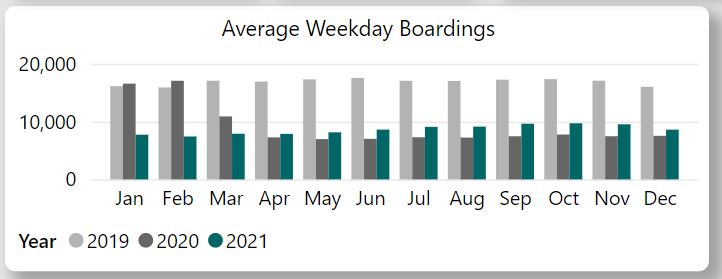
Senator Marko Liias said, “Aurora should be about moving people and goods, and not just moving cars”. We agree. Aurora’s bus line, the RapidRide E, carries the most riders of any in bus in the state at 17,000 per day (pre-pandemic). In 2021, as most office workers remained home, this route still carried about 10,000 riders per day. Moving people starts and ends with pedestrian access. Whether you’re in a wheelchair, moving to a bus stop, or getting out of your parked car, sidewalks are the most critical piece in our transportation infrastructure. Unfortunately, this is what the current Aurora Avenue design prioritizes last.
It’s time for the road to finally change.
Seattle deployed slower speed limits for Aurora in 2021 knowing that slowing cars reduce fatalities. But with two more deaths along the highway, it’s clear that lowering speed limits is not enough. If we really want it to be safer we must change the road’s design.
Sen. Carlyle has a bold plan to fund $50 million dollars to build a more livable highway for a ten-block stretch of Aurora. This is intended to spark a larger effort of revitalizing the whole thing in Seattle and beyond. This comes as the State of Washington and City of Seattle transportation departments begin their $2 million dollar study this spring on how to deploy more pedestrian safety improvements for Aurora.
Over the last year, the Aurora Reimagined Coalition utilized public outreach in the forms of surveys, public meetings, meetings with marginalized communities, and visioning workshops. All these people said the same thing, Aurora is loud, dangerous, and needs more safety. They all believe we need wider sidewalks, tree lined buffers, and bike lanes. Believe it or not, many people currently bike on the dangerous road, opting to use the Bus Only lanes to avoid the dangers of vehicles a few feet away.
Building a Shared Use Path
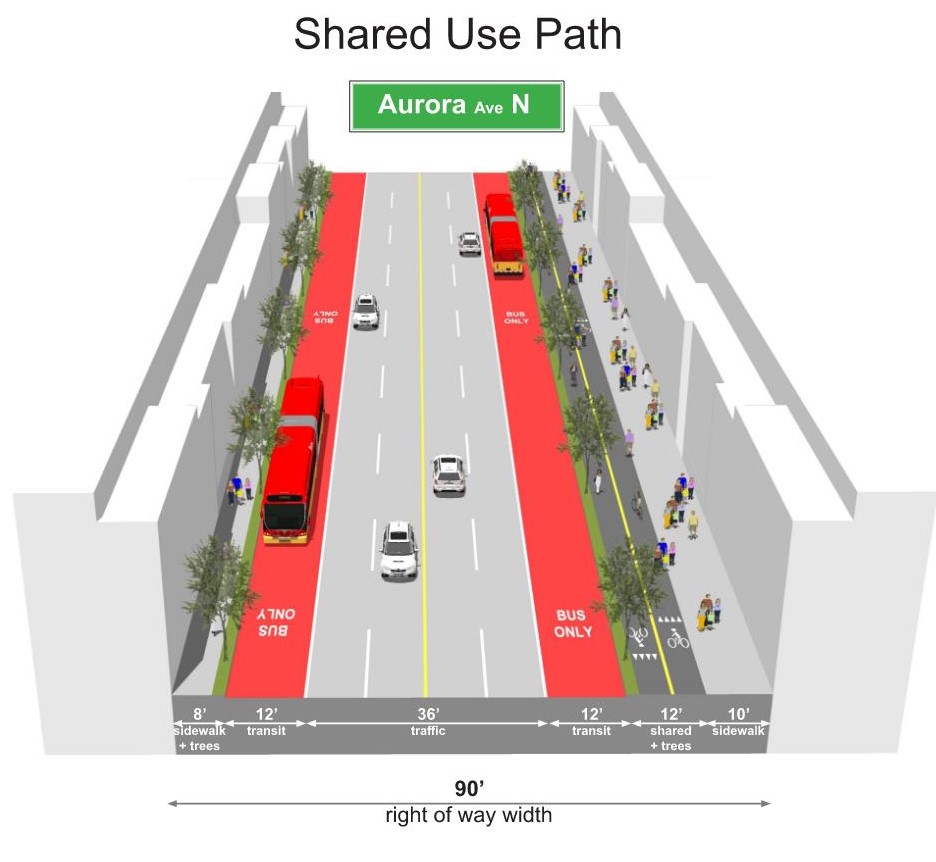
It turns out you can do a lot with 90 feet of road width. We have two ideas for how the state can step in and improve the segment of Aurora in the Senator’s demonstration project. One is less impactful, keeping the four general purpose lanes, two bus-only lanes, and making the sidewalk on the west side wide enough for trees and a multi-use path. The sacrifice here is only the turn lane and median. For this ten-block stretch through North Seattle, we can illustrate what pedestrian and cycling safety can do for the rest of the highway corridor and give people more space to move around safely. Plus, it will add trees and make it a more vibrant and livable experience for nearby businesses.
Planted median road diet
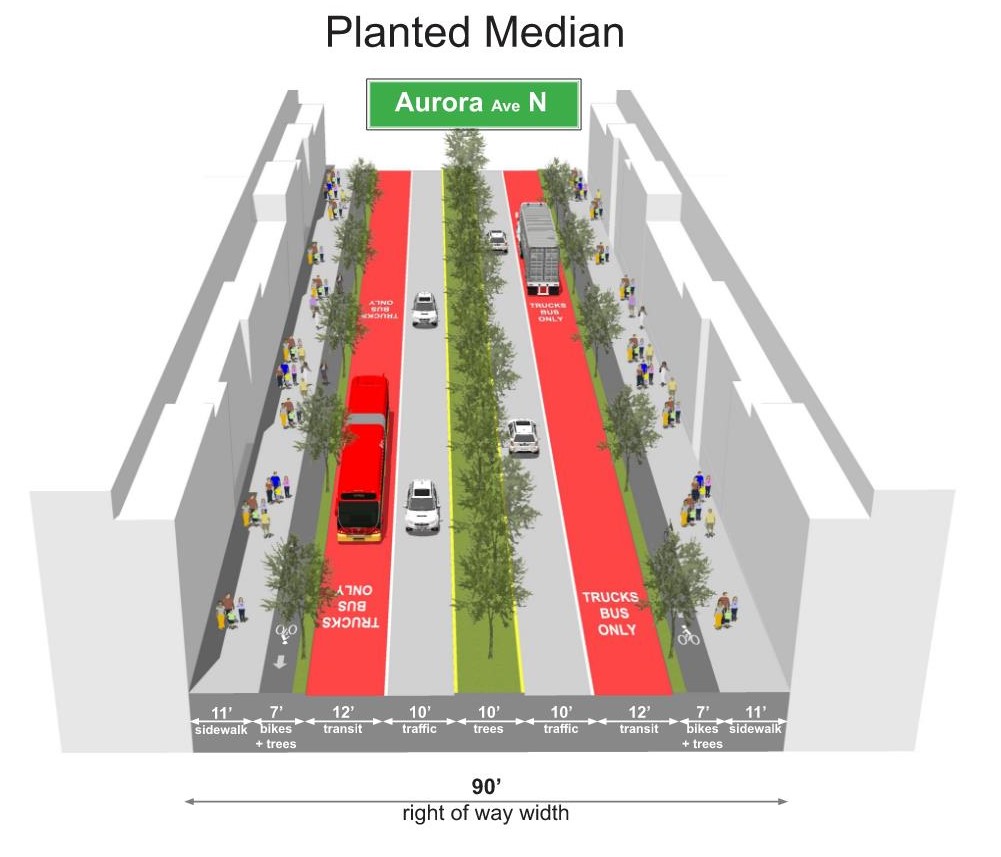
The second option is to look at fewer lanes, which will provide enough space to check every box of the community’s and Senator Carlyle’s wishes. The “road diet” would allow for a one-way cycle path on either side, landscaped buffer, tree lined median, bus only lanes, and much wider sidewalks. Considering this stretch of road is considered an “Urban Village Main Street” by the City of Seattle, these changes merely bring the stretch into compliance with their Streets Illustrated catalog.
Only the beginning
In either case, these changes are not enough. This case study won’t build sidewalks in Bitter Lake. Neighbors in the far north end of Aurora will still be forced to walk in the shoulder. This won’t remove the concrete barrier in Fremont or make the west side of Green Lake Park any more pleasant. It won’t correct the mistake we made bisecting Woodland Park and limiting the green space available for humans and animals alike. And it won’t reduce the scar that divides Queen Anne from Lake Union. Sen. Liias noted ambition was in order.
“We used to do big things in this city,” Liias said. “We connected lakes to the Sound, we moved entire hills. And now we think changing Aurora is too hard to accomplish?”
We agree. Even bigger things can and should be done.
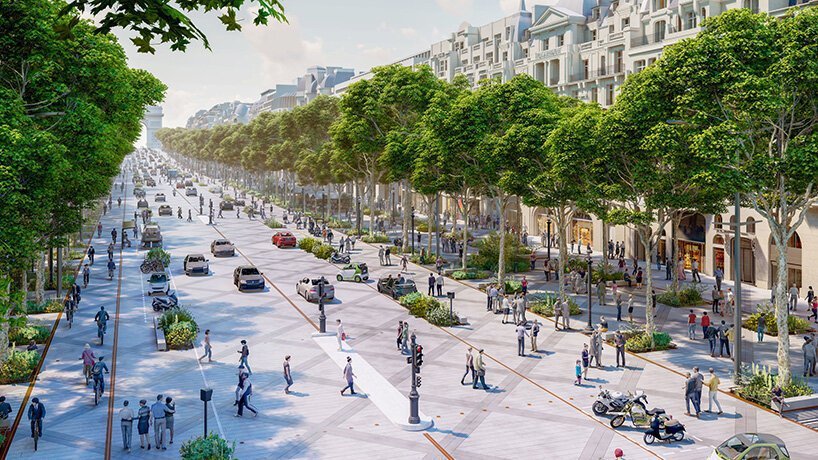
But this is just the beginning. Perhaps instead of $50 million we can ask for more? How about $99 million for 99’s Problems? The Move All Seattle Sustainably (MASS) Coalition (The Urbanist is a member) requested $150 million to redesign Aurora in the state transportation package in its ask to local legislators. So $99 million would be meeting them halfway.
It will take bold leadership to deliver a bold vision. If we want to build the Champs-Élysées of Seattle, then let’s commit to it. Let’s look beyond this ten block stretch and let’s reconnect our divided neighborhoods from Shoreline to South Lake Union. Let’s make this road safer. Let’s make this road more pleasant for the 1,000 more homes already permitted or under construction on Aurora’s blocks. Let’s make it a place where people want to be, like they’re on a stroll in Paris. Most of all, let’s make this road safe so nobody else has to die and we don’t have to update that PowerPoint slide anymore.
Let’s build the Aurora we deserve. One that is focused on safety, livability and sustainability. This is only the beginning. Just imagine the day this entire road is redone and is the vibrant vision we are painting today. When that day comes, we’ll look back at the Aurora that’s out there right now and wonder, what took us so long?
The Aurora Reimagined Coalition is a grassroots collective of community groups, safe street advocates, business owners, and active urban citizens who believe in sustainable solutions to improve our city and its roads. Learn more about the coalition at www.got99problems.org

